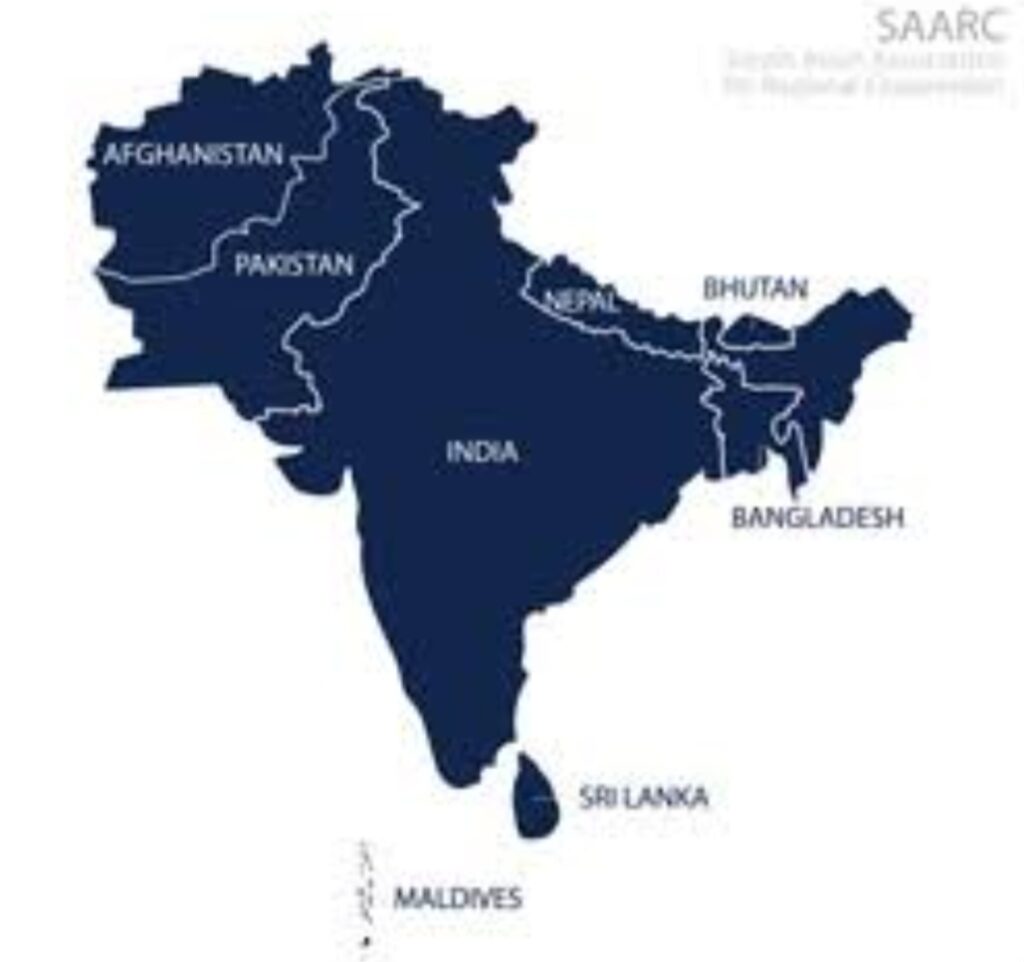By: Lt Col JS Sodhi (Retd), Editor, GSDN

South Asia with 25% of the world’s population with 2.04 billion and comprising India, Bangladesh, Bhutan, Maldives, Nepal, Pakistan, Sri Lanka and Afghanistan with per capita GDP of just US$ 2691.6 in 2024, is amongst the poorer regions of the world, though faring better than the African sub-regions. Western & Central Africa had per capita GDP of US$ 1284.20 last year. Per capita GDP of the ASEAN nations were US$ 5814 in 2024 and Central Asian nations had per capita GDP of US$ 5900 the same year.
Viswathika Gayathri’s famous quote “Poverty is the root cause of all evil” pretty much holds true as it explains why Western & Central Africa and South Asia periodically see unrest and uncertainty. These regions are perpetually mired in turbulence and turmoil with poverty being the root cause. For poverty gives rise to communalism, unrest and uncertainty.
In 2024, 75.6% of the population residing in South Asia lived below the poverty line on less than US$ 6.85 a day whilst 10.5% of the South Asian populations was mired in extreme poverty who lived on less than US$ 3 per day. Last year, the Western & Central African regions saw 35.7% of the population in extreme poverty. In 2024, Though the ASEAN nations had 10.8% of the population below the poverty line but no one lived below the extreme poverty line.
But amongst these regions in general and South Asia in specific, stands out India which despite not being a rich or developed nation has seen resilience and resoluteness in her pursuit for progress and prosperity. From mortgaging gold in 1991, today India is the world’s fourth largest economy.
India, a land of Unity in Diversity with a bouquet of 89 major and minor religions and 122 major languages and 1599 other languages that are spoken across the length and breadth of the country, has always seen peaceful transition of power and no national uprisings that have turned violent.
Be it the Taliban 2.0 seizing power by force in August 2021 or the dramatic Sri Lankan government change in July 2022 or the violent protests that shook Pakistan in May 2023 or the mayhem that seized Bangladesh in August 2024 or the massive student protests in Nepal in September 2025, India has never seen such chaos and mayhem and will never see in future too.
Three issues that have played a pivotal role in India standing strong as South Asia remains engulfed in chaos and confusion, are India’s well-written constitution, India’s independent judiciary and India’s apolitical and secular armed forces.
A good constitution is quintessential for a just and democratic society which sets the fundamental rules for governance, protects citizens’ rights, establishes a system of checks and balances to prevent abuse of power and fosters social cohesion.
The Indian Constitution adopted on November 26, 1949 and enacted on January 26, 1950 established India as a sovereign, socialist, secular, democratic republic with a federal parliamentary structure and parliamentary system of government. It outlines the framework for the government’s powers, duties, procedures as well as the fundamental rights and duties of citizens.
Certain features of the Indian Constitution are so integral to its functioning and existence that they can never be changed. This is also known as the Basic Structure Doctrine. This has ensured that the basic framework and foundation of the Indian Constitution can never be changed.
Pakistan since its creation in 1947 has seen three constitutions in 1956, 1962 and 1973. Nepal has seen seven constitutions in the last 77 years – 1948, 1951, 1959, 1962, 1990, 2007 and 2015.
Since gaining independence in 1948, Sri Lanka has seen three constitutions in 1948, 1972 and 1978. Afghanistan has seen eight constitutions in the last 102 years – 1923, 1931, 1964, 1987, 1990, 2004 and no formal constitution since 2021 as the Taliban government follows the Sharia law.
Clearly, the Indian Constitution has been so well-written that it has withstood the test of time. Whenever, any situation has risen which could shake the foundations of India, the Constitution has in-built features that have kept India united and strong.
The next issue that has kept India strong and united is India’s independent judiciary. The judiciary in India is composed of the Supreme Court at the top of the pyramidical justice system, followed by the state High Courts and then various subordinate courts, forming a hierarchal structure to administer justice and interpret law. The Indian judiciary functions as an independent guardian of the Indian Constitution and people’s fundamental rights.
The Indian judiciary has ensured that justice is dispensed within the framework of the Indian Constitution and various laws in force. However, a point of concern that needs mentioning is how some individuals tarnish and taint the Indian judiciary when judgements aren’t given as per their expectations. But when judgements are given as per their expectations then these very individuals praise the Indian judiciary. A classic case of never being graceful and gracious when things don’t turn out as per one’s desires.
These very people who criticize and condemn the Indian judiciary by often stating that there are over 51 million cases pending in the Indian courts, will never highlight that the number of Judges in India is only 21 per million as compared to 150 per million in the USA and 100 per million in the United Kingdom. They also never bring out that India has only 158 police personnel per million population as compared to 271 police personnel in the USA and 2400 police personnel in the United Kingdom per million population. The United Nation’s recommended strength of police personnel for every million population is 222.
In the Indian High Court, the average pendency for a court case is 3-5 years, whereas for the United Kingdom High Court it is 3-4 months and for the US High Court is just 2-4 months.
Needless to say, that swift justice in a very less time frame is directly proportional to the number of judges and police personnel.
The Indian judiciary has always upheld the Indian Constitution and the various laws and has never succumbed to fear or favour. The miniscule aberrations have been dealt very severely by the Collegium system that is existing in the Indian Supreme Court and the Indian High Courts.
The third pivot that has been instrumental in India’s rise compared to the other South Asian nations, is the Indian Armed Forces comprising the Indian Army, Indian Navy and Indian Air Force which are apolitical and secular.
The Indian Armed Forces unlike most militaries in the South Asian nations, have kept itself apolitical and secular. Be it a man-made tragedy or a natural disaster, the Indians have supreme confidence in the Indian Armed Forces and in every task assigned to the Indian Armed Forces by the political leadership of the time, the Indian Armed Forces has come out with flying colours.
The Indian Armed Forces have never seized power as most South Asian nations have this troubled history. This has ensured that India has always had political leadership at the helm of affairs and the path for peace and prosperity has been followed. For, the political leadership is best suited to govern the nation than its military.
Pakistan has been under military rule thrice from 1958-1971, 1977-1988 and 1999-2008. It is well known that the Pakistan Army even when not in political power, governs the nation from the shadows.
Bangladesh since its independence has seen 29 military coups and has seen military rule during the periods 1975-1981 and 1982-1990.
India has neither seen any period of military rule nor any attempted military coup. The Indian Armed Forces have only focussed on the defence of India from external aggressions and internal disorders.
Those who call for Indian Armed Forces to get political or mock its secular credentials, should look at the state Pakistan and Bangladesh are in today because of their militaries being political and communal.
As South Asia is deeply mired in uncertainties and is slipping, India stands strong with her well-written constitution, independent judiciary and apolitical & secular armed forces being the three major pivots.
There is no nation in South Asia, except India, which in the last eight decades has seen a democracy with the same constitution down the years, independent judiciary that has performed without and fear or favour and no military coups or military rule.
The well-written constitution, independent judiciary and apolitical & secular armed forces are India’s main pivots. Any attempt to tinker with these three pivots or even one of them, will prove detrimental for India.

About the Author
Lt Col JS Sodhi (Retd) is the Founder-Editor, Global Strategic & Defence News and has authored the book “China’s War Clouds: The Great Chinese Checkmate”. He tweets at @JassiSodhi24.


Sir, A well written article bringing out the strong points od India vis-a-vis it’s neighbours. Two aspects, I feel, we are grossly lacking in are Civil Society and a free mainstream media. Both are required to be strengthened to be able to show a mirror to the government of the day. Regards.